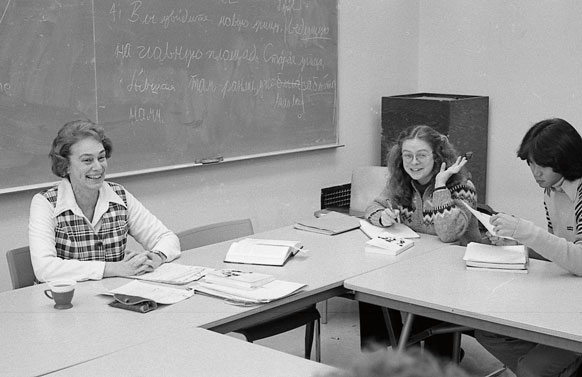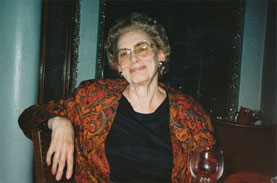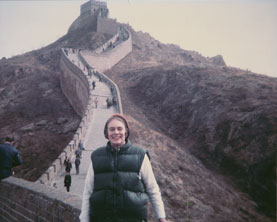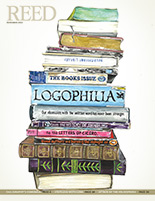
IRIS login | Reed College home Volume 91, No. 4: December 2012
In Memoriam
The Pursuit of Understanding

Carol, with students, 1978
Carol Creedon [psychology 1957–91]
July 5, 2012, in Portland.
By Lauren Rusk ’80
Carol Creedon was a woman of vast, unflinching understanding, who lived with great gusto, warmth, and love. A psychology professor from the 1940s to the 1990s, she spent her life seeking to increase her understanding of how people act and finding ways to help them.
After a decade of teaching at Vassar, Swarthmore, and Bard, and doing research in New York hospitals, Carol joined the faculty at Reed, where she’d wanted to work all along. For many people at Reed she became, in varying mixes, an influential teacher and counselor, a mentor and lifelong model, and, as in my case, an irreplaceable friend.
Initially her wide array of courses in human psychology drew students in, especially those eager to branch out after an introductory grounding in animal research. Examples of her many offerings were courses in abnormal, developmental, educational, and social psychology; personality; motivation; and the creative process. When I first studied with Carol in 1976, the fact that she taught human-centered courses had given her a reputation among students for being “the one who’s not a behaviorist.” Privately, Carol chuckled at this idea. After all, in conference, she insisted on the value of describing people’s behaviors rather than their “so-called character traits.” At home, she used operant conditioning to teach her Siamese cat to fetch, a game he then demanded at all hours. She also conditioned herself, indulging in pleasure reading only after reaching a milestone in some professional (or aversively domestic) task. Her areas of expertise included behaviorism—and much more.
Carol’s eclectic interests in psychology all stemmed, I believe, from the desire to develop knowledge that could measurably improve lives. Evidence was, for Carol, the sine qua non. Steve Lindsay ’81 has never forgotten the session in which he “asserted that love cannot be quantified, and she nailed me by asking, ‘Why not?’”
As an undergraduate at UCLA, Carol aspired to become a labor organizer and then, finding that public speaking was not her forte, looked forward to “an academic job in which I would be paid for doing what I like most, which is reading and thinking.” For Carol, however, the two spheres of action and contemplation were one. Majoring first in political science, then economics, and ultimately psychology, she thought about ways to make a difference.
This pragmatic idealism informed Carol’s teaching. In the late 1970s she was particularly excited about a course she’d just designed, Community Psychology and Social Change, which “applies psychological principles to the analysis of a wide range of community problems” such as “poverty, racism, drug addiction, juvenile delinquency, and adult crime.” Her enthusiasm persuaded a number of students to abandon the societal isolation then common at Reed and plunge into the course. With mixed emotions we received her customary half-inch-thick syllabus, including pages of optional extra readings and a long list of community agencies to choose from in carrying out a fieldwork project. We could either serve at an agency while analyzing its “structure, function, and ideology” or perform a systematic evaluation—one of Carol’s passions—to discover “the degree to which a social program is achieving its objectives.”
Most of Carol’s courses had a “real-world” component, “one of the few opportunities at Reed,” Gena Anderson ’99 recalls, to “see how theory and practice collide.” Placements included crisis centers, a suicide hotline, a short-stay psychiatric hospital, a drug-detox facility, homeless shelters with children’s programs, and, of course, schools. Rosanne Kermoian [psychology 1987–90] marvels at how well Carol prepared both the agencies and the undergraduates and hence how many organizations seemed eager to employ the talents of Reed students. Clearly Carol enhanced Reed’s town-gown relations. Her students moved back and forth between the campus and the community, got a feel for the profession they were considering, and gained experience that would make them attractive to top graduate programs. Similarly, Carol’s educational psychology course helped make students who earned a Master’s of Arts in Teaching at Reed [1959–79] especially desirable to schools across the nation.
In her oral history interview with Jim Kahan ’64, Carol attributes her succession of majors at UCLA to a series of dynamic professors. “It’s sort of embarrassing, I know. It should [have been] the subject matter which grabbed me,” she confesses. “But I think the initial interest had to do with marvelous teaching, which I later on tried to emulate but never quite managed, in my view at least.” Generations of devoted Reedies would beg to differ.
Carol embraced Reed’s conference style of teaching even though “it could be a little scary.” Steve Lindsay remembers her having “the patience and courage to just sit there looking engaged and mildly expectant if discussion lagged.” Carol “rarely leapt in, but she somehow inspired us to dig in” to complex issues. Myron Rothbart ’62 writes that she had “an uncanny ability to paraphrase the most confused, inarticulate comment, in a way that made it sound like a major contribution to the discussion, and to the field of psychology! At base, it conveyed a respect for the student, and a focus on—above all else—the ideas.”
In a similar vein, Dell Rhodes [psychology 1975–2006] recalls how gracefully Carol would steer department meetings back on course. “She would sit quietly while others arm wrestled, then calmly begin, ‘Have we considered . . .’ or ‘Didn’t we previously agree to . . . .’” In tumultuous times she’d also calm the waters by “arriv[ing] with a bottle of sherry.”
Carol’s most profound effects, however, generally took place one to one. For many people, the process began in her office in the basement of Eliot Hall. Carol’s desk, a table for provisions, and a visitor’s chair clustered by the door; at the other end, a high window faced the duck pond. In between, a maze of bookshelves, files, and “boxes of who-knows-what” crowded the space, scattered with “flotillas of yellow sticky notes,” Dell remembers. “Finding something in Carol’s office”—a library for the entire department—“meant negotiating narrow passageways through her holdings.”
Many former students report feeling intimidated in Carol’s presence at first, then quickly being set at ease, which was my experience as well. This tailored woman in her 50s, who had just asked some question about why I was there, gave me a long, searching look through large-framed glasses. What could she discern? Whatever my excuse, I’d probably come to try and imagine changing my major from painting to psychology. More deeply, what I wanted was a friend. Groping about for a coherent answer, I looked up and saw her generous mouth stretch into a smile and her eyes glint with pleasure. From the clutter around her desk emerged the wherewithal to make hot chocolate and various sorts of tea. Before long I was airing a tangle of excitements and self-doubts, and feeling, most of all, appreciated, fortified.
After such encouraging beginnings, numerous students modeled themselves after Carol, becoming professors, researchers, and clinicians. In some cases, without her aid at crucial times, this might not have happened. Anne Dickerson Riley ’79 writes that Carol’s “unwavering faith in my ability to succeed at Reed inspired me to stay when my personal life was in chaos, to complete my thesis when I wanted to quit, and to submit it for publishing when I didn’t believe it was worthwhile.” Carol helped many students devise compelling research, write about it, and present and publish their findings. Contributing her credentials as coauthor—never first author—often smoothed the way forward. She urged those who doubted themselves to apply to graduate schools “just to keep your options open.”
Ca
Carol’s influence has continued to resound through the lives of her protégés, sometimes from one generation to another. For example, Carol’s student and colleague Barbara Hort ’74 [psychology 1990–92] found her “favorite professors and best friends” in grad school to be Mick Rothbart ’62 and Mary Klevjord Rothbart ’62, who had studied with Carol earlier. Likewise, after Carol recommended to David Sears ’98 a book about cooperative learning, based on research by Robert Slavin ’72 and Nancy Madden ’73, he wrote his own thesis in that area and then “headed off to work [with] Nancy and Bob.”
Younger psychology professors at Reed also resorted to Carol’s office to get their bearings. Marion Underwood [psychology 1991–98] remembers Carol’s encouragement in setting boundaries, her bracing empathy—along with an occasional “airplane-sized bottle of hard liquor”—and her sometimes unprintable humor. “I sometimes felt quite ‘at sea’ after Carol retired,” Dell writes. Fortunately, though, she “continued to be a presence . . . for years after her formal retirement, coadvising thesis students and raising our spirits with her laughter.”
Carol’s laugh . . . her admirers all remember that loud, almost raucous explosion of delight. Sometimes we were left in its wake to ponder just what was so darn funny. If the door to her office or classroom were open, Carol’s laughter would echo down the hall. Her colleague Allen Neuringer [psychology 1970–2008] still cherishes that echo. And “one always felt special,” Dell observes, “when successful at eliciting a full-throated Creedon laugh.” Or else you felt, as I often did, that things must be better than you’d thought.
Carol’s restorative effects were not limited to her department. Bruce Auerbach ’69 remembers that in the ’60s Carol “served as unofficial psychotherapist to a sizeable portion of the student body. . . . There was always a line outside Carol’s door of people . . . looking for someone who would listen and help them talk through their problems. Carol did her best to keep her students and their friends sane and grounded.” Indeed, as her son, Jonathan Creedon ’77, recounts, Carol sometimes even “care[d] for drug-stricken students at her home. She would dry them out and nurse them back to full function, all the time collecting their assignments at school and ensuring their completion so they would not fail or drop out.”
Th
Ca
At any rate, Carol enjoyed herself tremendously. She relished physical and aesthetic pleasures, and had a fine sense of nuance, especially regarding people’s inconsistency. Once when I wanted something—or was it somebody?—very much, she said, “Maybe we should get someone who believes in God to pray for it, just in case,” and flashed me a sidelong smile.
When it came to sabbaticals, Carol believed in adventure. In 1970 she worked in the Ngorongoro Crater in Tanzania. Each day, she and a student assistant lay with binoculars atop a Land Rover, researching aggression in baboons. In the evenings, they were invited to the tribal ceremonies of the Maasai. For her next sabbatical, Carol studied the psychological and social aspects of aging in the new China. She also hiked the Great Wall, became the only one in her tour group to use Eastern toilets, and watched a throat operation performed with no anesthesia but acupuncture, while the psychiatrist in her group fainted away.
Carol found time to make her impact felt more broadly as well. She collaborated with scholars nationwide, and in particular coedited the anthology Children and Poverty: Some Sociological and Psychological Perspectives. She held office in many organizations, in areas such as alternative education, racial equality, adult literacy, abuse prevention, and civil liberties. In addition, she reviewed educational films for the American Association for the Advancement of Science and grant proposals for the NSF.
What Carol couldn’t spare the time for was cultivating “visibility.” Walking across campus, she didn’t think to schmooze, not when there were books on tape! From the advent of cassette players to their lamented (by her) demise, Carol was hardly to be seen without one buckled around her waist. Work and pleasure, closely allied, were all.
Now and then she’d play for an advisee the revival hymn “Work, for the Night Is Coming.” “That’s the ticket! Marvelous, isn’t it?” she’d say. “Just marvelous!
Poet and critic Lauren Rusk ’80 teaches at Stanford University.




LATEST COMMENTS
steve-jobs-1976 I knew Steve Jobs when he was on the second floor of Quincy. (Fall...
Utnapishtim - 2 weeks ago
Prof. Mason Drukman [political science 1964–70] This is gold, pure gold. God bless, Prof. Drukman.
puredog - 1 month ago
virginia-davis-1965 Such a good friend & compatriot in the day of Satyricon...
czarchasm - 4 months ago
John Peara Baba 1990 John died of a broken heart from losing his mom and then his...
kodachrome - 7 months ago
Carol Sawyer 1962 Who wrote this obit? I'm writing something about Carol Sawyer...
MsLaurie Pepper - 8 months ago
William W. Wissman MAT 1969 ...and THREE sisters. Sabra, the oldest, Mary, the middle, and...
riclf - 10 months ago